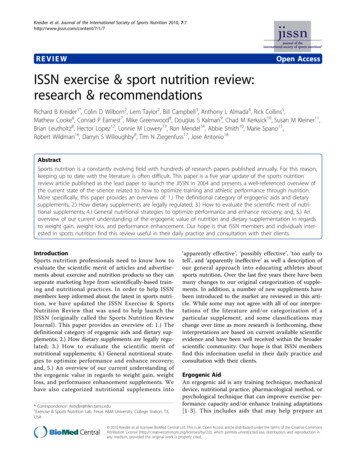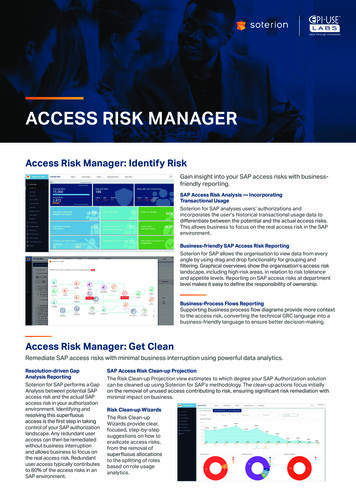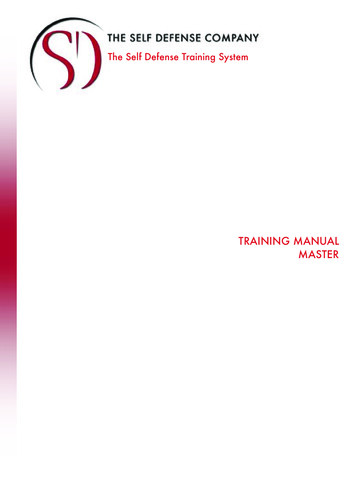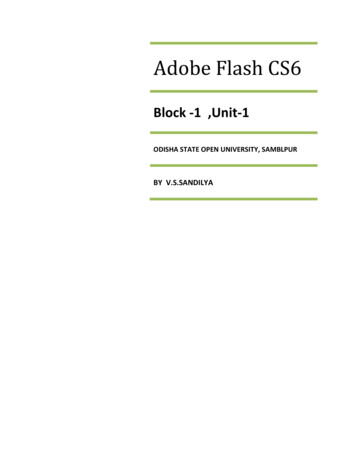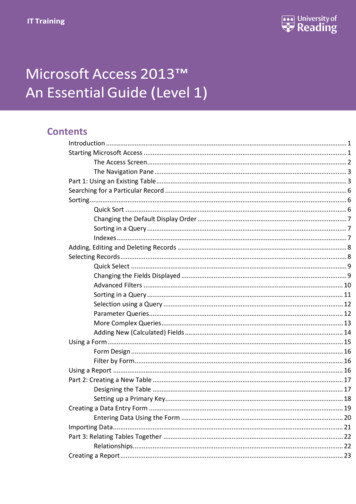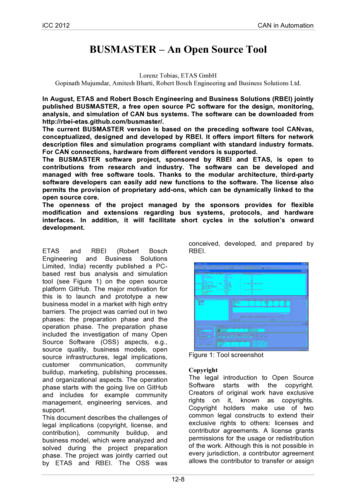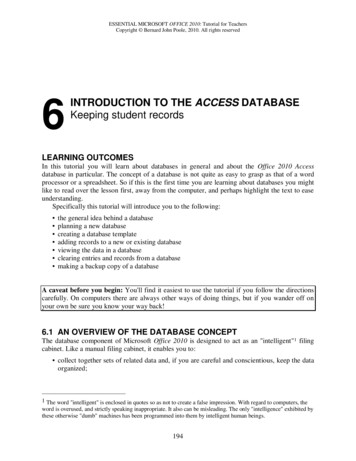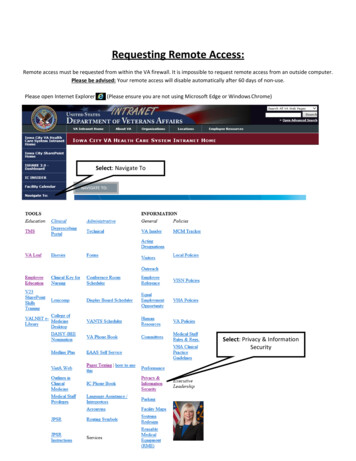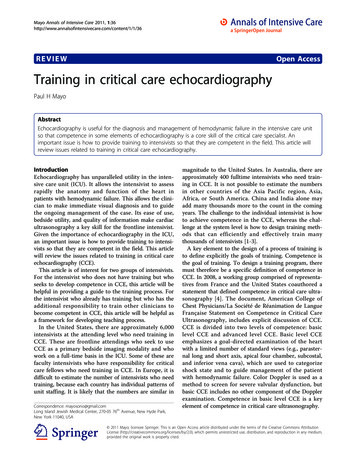
Transcription
Mayo Annals of Intensive Care 2011, /1/36REVIEWOpen AccessTraining in critical care echocardiographyPaul H MayoAbstractEchocardiography is useful for the diagnosis and management of hemodynamic failure in the intensive care unitso that competence in some elements of echocardiography is a core skill of the critical care specialist. Animportant issue is how to provide training to intensivists so that they are competent in the field. This article willreview issues related to training in critical care echocardiography.IntroductionEchocardiography has unparalleled utility in the intensive care unit (ICU). It allows the intensivist to assessrapidly the anatomy and function of the heart inpatients with hemodynamic failure. This allows the clinician to make immediate visual diagnosis and to guidethe ongoing management of the case. Its ease of use,bedside utility, and quality of information make cardiacultrasonography a key skill for the frontline intensivist.Given the importance of echocardiography in the ICU,an important issue is how to provide training to intensivists so that they are competent in the field. This articlewill review the issues related to training in critical careechocardiography (CCE).This article is of interest for two groups of intensivists.For the intensivist who does not have training but whoseeks to develop competence in CCE, this article will behelpful in providing a guide to the training process. Forthe intensivist who already has training but who has theadditional responsibility to train other clinicians tobecome competent in CCE, this article will be helpful asa framework for developing teaching process.In the United States, there are approximately 6,000intensivists at the attending level who need training inCCE. These are frontline attendings who seek to useCCE as a primary bedside imaging modality and whowork on a full-time basis in the ICU. Some of these arefaculty intensivists who have responsibility for criticalcare fellows who need training in CCE. In Europe, it isdifficult to estimate the number of intensivists who needtraining, because each country has individual patterns ofunit staffing. It is likely that the numbers are similar inCorrespondence: mayosono@gmail.comLong Island Jewish Medical Center, 270-05 76th Avenue, New Hyde Park,New York 11040, USAmagnitude to the United States. In Australia, there areapproximately 400 fulltime intensivists who need training in CCE. It is not possible to estimate the numbersin other countries of the Asia Pacific region, Asia,Africa, or South America. China and India alone mayadd many thousands more to the count in the comingyears. The challenge to the individual intensivist is howto achieve competence in the CCE, whereas the challenge at the system level is how to design training methods that can efficiently and effectively train manythousands of intensivists [1-3].A key element to the design of a process of training isto define explicitly the goals of training. Competence isthe goal of training. To design a training program, theremust therefore be a specific definition of competence inCCE. In 2008, a working group comprised of representatives from France and the United States coauthored astatement that defined competence in critical care ultrasonography [4]. The document, American College ofChest Physicians/La Société de Réanimation de LangueFrançaise Statement on Competence in Critical CareUltrasonography, includes explicit discussion of CCE.CCE is divided into two levels of competence: basiclevel CCE and advanced level CCE. Basic level CCEemphasizes a goal-directed examination of the heartwith a limited number of standard views (e.g., parasternal long and short axis, apical four chamber, subcostal,and inferior vena cava), which are used to categorizeshock state and to guide management of the patientwith hemodynamic failure. Color Doppler is used as amethod to screen for severe valvular dysfunction, butbasic CCE includes no other component of the Dopplerexamination. Competence in basic level CCE is a keyelement of competence in critical care ultrasonography. 2011 Mayo; licensee Springer. This is an Open Access article distributed under the terms of the Creative Commons AttributionLicense (http://creativecommons.org/licenses/by/2.0), which permits unrestricted use, distribution, and reproduction in any medium,provided the original work is properly cited.
Mayo Annals of Intensive Care 2011, /1/36Advanced-level CCE requires that the clinicianachieves competence in aspects of echocardiographythat are part of standard cardiology-type echocardiography, in addition to achieving competence in elements ofechocardiography that are particular to critical caremedicine. Competence in advanced-level CCE requires along course of study similar in complexity to the cardiologist who is trained in echocardiography. It includestraining in transesophageal echocardiography (TEE).Competence in advanced level CCE is not a key elementof competence in critical care ultrasonography. Themajority of intensivists do not have the time, the interest, or the need for advanced level of training. It is notclear what proportion of intensivists should acquireadvanced level. One approach in a large ICU that isstaffed by a full-time intensivist team is for several teammembers to have advanced CCE training, whereas allother team members have basic CCE skill. This allowsready access to advanced CCE capability, should theclinician with basic level CCE skill need backup.The importance of the Statement on Competence isthat it clearly defines competence in both types of CCE.It therefore has utility for both the trainee and the trainer, because it provides a road map for training. It hasbeen adopted as the foundation document for a multinational consensus statement on training in critical careultrasonography.Following the development of the Statement on Competence, a working group met in 2009 to develop guidelines for training in critical care ultrasonography.Representatives from major critical care organizations ofEurope, North America, America, the Middle East, andthe Asia-Pacific region met under the aegis of the European Society of Intensive Care Medicine. The resultingdocument, International Expert Statement on TrainingStandards for Critical Care Ultrasonography, is based onconsensus of the group and addresses the question ofhow to train to become competent in both basic andadvanced CCE [5].For training in basic CCE, the working group decidedthat the theoretical component of training shouldinclude a minimum of 10 hours of course work, combining lecture, didactic cases, and image interpretation.The learning may utilize a blend of lecture format andinternet-based material. For training in image acquisition, a minimum of 30 fully supervised studies is suggested as a reasonable target. Initially, training scansmay be performed on normal subjects. A key part oftraining includes a component of bedside scanning ofpatients in the ICU under the supervision of a localexpert who is competent in basic CCE. For training inimage interpretation, the trainees should be exposed toa comprehensive collection of abnormal images, becauseit is not expected that they will see all importantPage 2 of 5pathology during their image acquisition training. Thetrainee should keep a logbook of scanning activity andmake formal readings of their scans under supervisionof their trainer. Training in TEE is an optional component of basic CCE.Training in advanced CCE requires a minimum of 40hours of course work using the same techniquesdescribed for basic CCE. Image acquisition trainingrequires a suggested minimum of 150 transthoracic(TTE) and 50 TEE studies performed under the directsupervision of a local expert. In other respects, trainingmethods are similar as with basic CCE, using blendedtechniques for cognitive training, image interpretationfrom a comprehensive image collection, and initial training with normal subjects followed by extensive bedsidescanning under direct supervision of a local expert.The working group decided that a formal certificationprocess for basic CCE was not required but that a certification process was required to ensure competence inadvanced CCE given the complexity of the field and theneed for recognition of high skill level by colleagues andadministrative entities.The Statement on Competence is very specific. TheStatement on Training is less so. For example, therequirement for number of studies needed for trainingis a suggested target, because the group felt that therewas insufficient evidence to make a more definitiverecommendation. The document establishes a broadstandard to allow maximum flexibility in design of training programs in a wide variety of medical cultures.However, one unequivocal statement is as follows: basiclevel critical care echocardiography and general criticalcare ultrasound should be a required part of the trainingof every ICU physician [5].When undertaking training in CCE, the trainee mayask whether intensivists can actually perform the procedure. The emphatic answer must be in the affirmative. There is nothing intrinsic to cardiology trainingthat limits echocardiography to the cardiologist. It issimply another imaging technique that can be learnedby any interested clinician; but is there evidence thatsupports this contention? Many groups have demonstrated that noncardiologists can be trained to performcomponents of the basic CCE examination with reliableresults [6-15]. The American Society of Echocardiography have issued a recent position paper that supportsthe use of limited echocardiography by emergencymedicine physicians–a group that has close parallel tothe critical care specialist [16]. In reference specificallyto intensivists, Manasia et al. reported on the utilityand accuracy of goal-directed TTE performed by intensivists with positive results [17]. Vignon et al. observedthat critical care residents could master basic CCE withresults similar to expert level echocardiographers [18].
Mayo Annals of Intensive Care 2011, /1/36It is clear that intensivists can become competent inbasic CCE.Regarding advanced CCE, there are well-defined training tracks that produce intensivists who are clearly competent at an advanced level. This reality exists withoutthe need for study.Although the Statement on Training Standards offerssuggestions for target number of studies, there is nowevidence that supports these recommendations. Vignonet al. reported that approximately 33 TTE are adequatefor training in basic CCE for most critical care residentswhen combined with a 12-hour learning program blending didactics, interactive clinical cases, and tutoredhands on sessions [19]. Charron et al. reported thatapproximately 30 studies are required for reasonablecompetence in limited TEE [20]. This study is of particular interest, because it examined the progression ofskill acquisition during training and describes a methodical approach to testing for competence in TEE. Benjamin et al. reported that only ten TEE studies wererequired for intensivists to become competent in screening TEE, but the complexity of the examination was lessthan that used in the Vieillard-Baron study [21].Training should result in competence, but this is notassured. Much depends on the motivation of the learner.Poorly structured didactic lectures may not be effectivein knowledge transfer. Key to the training process is aninterested and effective bedside expert who has thepatience to supervise the inexperienced trainee. Numerical goals may foster the attitude that competence maybe achieved by performing a large number of low-quality scans as rapidly as possible. Instructors will note awide range of intrinsic talent in the learners at a course.Some lack the eye-hand coordination required for effective transducer manipulation while others have an intuitive grasp of the subject. Learners progress at their ownpace. Defining the training process and sending the learner through a well-defined training process does notguarantee competence.This raises the issue of certification. The argument infavor of a formal certification process for CCE is that itmay ensure that the participant has reached some predefined skill level. It defines an important minimumstandard. Presumably, this would yield better results atthe bedside. There are several arguments against developing a formal certification process for basic CCE.Assuming that basic CCE is a key skill for all intensivists, a large number of intensivists would need to gothrough the certification process. This presents logisticalproblems that are compounded by the complexitiesrelated to transnational differences of medical trainingpractice and testing methods. It is likely that differentnational societies would want to design their own certification process. For a certification process to by trulyPage 3 of 5meaningful, it must be designed by an agency that iscompletely independent of the training system to avoidconflict of interest.In the United States, the authority responsible fordeveloping the highest standard of certification, theAmerican Board of Internal Medicine, has not beeninterested in developing a certification process for arelatively small aspect of critical care medicine. Thetime and expense required to develop a high-grade certification process are considerable and do not warrantresource allocation for a skill that is of importance toonly small group of clinicians. This is likely to be thecase in other countries as well. Basic CCE is only asmall part of the large skill set required for the practiceof critical care medicine. If certification in basic CCE isa requirement to demonstrate competence, why notrequire certification in other aspects of critical caremedicine that are clearly of much higher risk and complexity, such as airway management, vascular access, orventilator management? This argument favors the position that basic CCE should be bundled into otherimportant aspects of critical care practice that do notrequire individual certification.By common consensus, training in advanced CCErequires formal demonstration of competence, if possible with certification by an agency that is independentof the training system. This ideal has been achieved inFrance, where the critical care community has developeda structured pathway for training in advanced CCE thatleads to certification. During the first year, the fellowtrains in echocardiography alongside cardiology fellowsand is required to perform at least 120 TTE studies.During the second year, they continue their trainingunder the direct supervision of an expert-level criticalcare echocardiographer. They are required to performan additional 120 studies, of which 50 must be TEE.They are mandated to attend a standard set of didacticcourses. On completion of these requirements, theymust pass a high stakes board-type examination that hasa significant failure rate. During the first 2 years ofoperation of this program, 200 intensivists achieved certification in advanced CCE, and 39% of fellowship programs are certified to provide the training.The French certification process, which was developedwith the support of the national cardiology and anesthesiology societies, is clearly a model for others to follow[1]. A similar training track is available for attendinglevel intensivists and anaesthesiologists, which requires40 hours of didactic training and performance of 100TTE and 50 TEE studies (25 performed and 25reviewed).In Australia and New Zealand, the critical care community has developed a two-tier system for training inCCE. Basic level training requires 10 hours of course
Mayo Annals of Intensive Care 2011, /1/36work and 30 TTE studies with logbook documentationand written report with guidance of a supervisor. Noformal examination is required for basic CCE.The Australian Society of Ultrasound in Medicine(ASUM) has developed a certification process foradvanced CCE. The Diploma in Diagnostic Ultrasound(DDU), well established in Australia and New Zealandfor the past two decades, catering to radiologists, cardiologists, and obstetricians, has been extended to CCE.The DDU in critical care was offered for the first timein 2010. It consists of two examinations: the first part isa physics examination common to all the different DDUsubgroups, and a second examination orientated to thecritical care physician. The practical requirements foradvanced CCE are similar to those outlined by theInternational Expert Statement on Training Standardsfor Critical Care Ultrasonography in terms of number ofstudies and the need for a logbook and supervisor.Intensivists who successfully complete the training program and the examination obtain a well-established qualification that is recognized throughout both Australiaand New Zealand.In the United States, there is no formal means for theintensivist to achieve high-level certification in advancedCCE. The National Board of Echocardiography (NBE)has established a policy that they will provide certification in echocardiography only to physicians who havecompleted full fellowship training in cardiology. There isno plan for the board to develop a separate certificationtrack for CCE similar to that in France or Australia/New Zealand. However, the NBE allows any licensedphysician to take the echocardiography boards, includingintensivists. Curiously, many cardiologists have decidednot to take the echocardiography boards. This meansthat they cannot receive certification in echocardiography by the NBE. As an alternative approach, cardiologists who elect not to take the examination may chooseanother pathway to demonstrate competence in echocardiography, which is described in a statement developed by the major cardiology societies [22]. Intensivistsalso may satisfy these requirements, and, if they do, theyare competent in echocardiography to equal degree as acardiologist. The best approach for the intensivist in theUnited States is to satisfy the requirements of the cardiology statement and also to pass the echocardiographyboards. The boards are not required to fulfil requirements for competence. So why take them? The reason isthat the intensivist should seek to demonstrate the highest level of capability when presenting themselves astrained in advanced CCE.Training fellows is less challenging than trainingattending level intensivists who did not have opportunityto gain experience during their fellowship years. Fortraining fellows, each medical culture will arrive at itsPage 4 of 5own solution for designing an effective trainingsequence for basic and advanced CCE. The French andAustralian/New Zealand system of fellow training is particularly relevant. As to the challenge for clinicians following their fellowship years, it may be instructive toreview one approach to the problem of training largenumbers of attending level critical care clinicians inbasic level CCEIn the United States, the American College of ChestPhysicians (ACCP) has developed a program designedfor the attending intensivist who seeks training in critical care ultrasonography (thoracic, cardiac, abdominal,and vascular). The total training sequence requires 7days of course attendance (3-day course followed 4months later by a 4-day consolidation course), 20 hoursof internet based training [23], performance of a 300image portfolio, and a high stakes board-type examination. The examination includes scripted hands on examination with a human model where the trainee isrequired to demonstrate skill at image acquisition. Theprogram is designed to give the participant training inall aspects of critical care ultrasonography, includingbasic CCE. Of the 56 hours of mandatory course attendance, 28 hours are devoted to basic CCE (4 hoursdidactic lectures, 12 hours of image interpretation training, and 12 hours of hands on training with a facultytrainee ratio of 3:1). The internet-based training has 12hours that covers basic CCE. The trainee must submit30 five-view basic echocardiographic studies of acceptable quality for a total of 150 video clips that arereviewed and accepted or rejected by a faculty reviewer.If the trainee passes the examination, they receive a certificate of completion. The ACCP has declined to labelthis as certification, because they feel that the AmericanBoard of Internal Medicine must be involved in the process as an external agency.ConclusionsBasic level critical care echocardiography should be arequired part of the training of every ICU physician. TheStatement on Competence and The Statement on Training Standards serve as useful guides both for the intensivist who seeks training and for faculty intensivists whowill be training their colleagues in this important skill.Competing interestsThe authors declare that they have no competing interests.Received: 12 April 2011 Accepted: 30 August 2011Published: 30 August 2011References1. Vieillard-Baron A, Slama M, Cholley B, Janvier G, Vignon P:Echocardiography in the intensive care unit: from evolution torevolution? Intensive Care Med 2008, 34:243-249.
Mayo Annals of Intensive Care 2011, .20.21.Cholley B, Vieillard-Baron A, Mebazaa A: Echocardiography in the ICU.Time for widespread use! Intensive Care Med 2006, 32:9-10.Poelaert J, Mayo P: Education and evaluation of knowledge and skills inechocardiography. How should we organize? Intensive Care Med 2007,33:1684-1686.Mayo PH, Beaulieu Y, Doelken P, Feller-Kopman D, Harrod C, Kaplan A,Oropello J, Vieillard-Baron A, Axler O, Lichtenstein D, Maury E, Slama M,Vignon P: American College of Chest Physicians/La Société deRéanimation de Langue Française Statement on Competence in CriticalCare Ultrasonography. Chest 2009, 135:1050-1060.International Expert Statement on Training Standards for Critical CareUltrasonography. Intensive Care Med 2011.Mandavia DP, Hoffner RJ, Mahaney K, Henderson SO: Bedsideechocardiography by emergency physicians. Ann Emerg Med 2001,383:77-382.Moore CL, Rose GA, Tayal VS, et al: Determination of left ventricularfunction by emergency physician echocardiography of hypotensivepatients. Acad Emerg Med 2002, 9:186-193.Vignon P, Chastagner C, François B, Martaillé JF, Normand S, Bonnivard M,Gastinne H: Diagnostic ability of hand-held echocardiography inventilated critically ill patients. Critical Care 2003, 7:R84-R91.Randazzo MR, Snoey ER, Levitt MA, Binder K: Accuracy of emergencyphysician assessment of left ventricular ejection fraction and centralvenous pressure using echocardiography. Acad Emerg Med 2003,10:973-977.Lemola K, Yamada E, Jagasia D, Kerber RE: A hand-carried personalultrasound device for rapid evaluation of left ventricular function: useafter limited echo training. Echocardiography 2003, 20:309-312.DeCara JM, Lang RM, Koch R, Bala R, Penzotti J, Spencer KT: The use ofsmall personal ultrasound devices by internists without formal trainingin echocardiography. Eur J Echocardiogr 2003, 4:141-147.Pershad J, Myers S, Plouman C, Rosson C, Elam K, Wan J, Chin T: Bedsidelimited echocardiography by the emergency physician is accurateduring evaluation of the critically ill patient. Pediatrics 2004, 114:e667-e671.Jones AE, Tayal VS, Sullivan DM, Kline JA: Randomized, controlled trial ofimmediate versus delayed goal-directed ultrasound to identify the causeof nontraumatic hypotension in emergency department patients. CritCare Med 2004, 32:1703-1708.Royse CF, Seah JL, Donelan L, Royse AG: Point of care ultrasound for basichaemodynamic assessment: novice compared with an expert operator.Anaesthesia 2006, 61:849-855.Melamed R, Sprenkle MD, Ulstad VK, Herzog CA, Leatherman JW:Assessment of left ventricular function by intensivists using hand-heldechocardiography. Chest 2009, 135:1416-1420.Labovitz AJ, Noble VE, Bierig M, Goldstein SA, Jones R, Kort S, Porter TR,Spencer KT, Tayal VS, Wei K: Focused cardiac ultrasound in the emergentsetting: a consensus statement of the American Society ofEchocardiography and American College of Emergency Physicians. J AmSoc Echocardiogr 2010, 23:1225-1230.Manasia AR, Nagaraj HM, Kodali RB, Croft LB, Oropello JM, Kohli-Seth R,Leibowitz AB, DelGiudice R, Hufanda JF, Benjamin E, Goldman ME:Feasibility and potential clinical utility of goal-directed transthoracicechocardiography performed by noncardiologist intensivists using asmall hand-carried device (SonoHeart) in critically ill patients. JCardiothorac Vasc Anesth 2005, 19:155-159.Vignon P, Dugard A, Abraham J, Belcour D, Gondran G, Pepino F, Marin B,François B, Gastinne H: Focused training for goal-oriented hand-heldechocardiography performed by noncardiologist residents in theintensive care unit. Intensive Care Med 2007, 33:1795-1799.Vignon P, Mücke F, Bellec F, Marin B, Croce J, Brouqui T, Palobart C,Senges P, Truffy C, Wachmann A, Dugard A, Amiel JB: Basic critical careechocardiography: validation of a curriculum dedicated tononcardiologist residents. Crit Care Med 2011.Charron C, Prat G, Caille V, Belliard G, Lefèvre M, Aegerter P, Boles JM,Jardin F, Vieillard-Baron A: Validation of a skills assessment scoring systemfor transesophageal echocardiographic monitoring of hemodynamics.Intensive Care Med 2007, 33:1712-1718.Benjamin E, Griffin K, Leibowitz AB, Manasia A, Oropello JM, Geffroy V,DelGiudice R, Hufanda J, Rosen S, Goldman M: Goal-directedtransesophageal echocardiography performed by intensivists to assessPage 5 of 5left ventricular function: comparison with pulmonary arterycatheterization. J Cardiothorac Vasc Anesth 1998, 12:10-15.22. ACC/AHA clinical competence statement on echocardiography. J AmColl Cardiol 2003, 41:687-708.23. ICCU imaging. 86/2110-5820-1-36Cite this article as: Mayo: Training in critical care echocardiography.Annals of Intensive Care 2011 1:36.Submit your manuscript to ajournal and benefit from:7 Convenient online submission7 Rigorous peer review7 Immediate publication on acceptance7 Open access: articles freely available online7 High visibility within the field7 Retaining the copyright to your articleSubmit your next manuscript at 7 springeropen.com
will review the issues related to training in critical care echocardiography (CCE). This article is of interest for two groups of intensivists. For the intensivist who does not have training but who seeks to develop competence in CCE, this article will be helpful in provid
